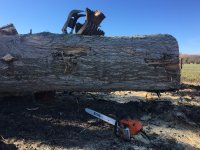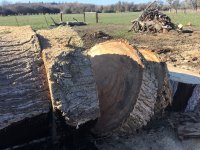Yes, a great way to clear out the noodles is to periodically change the angle so that you blow some finer dust through. I have some saws where this isn't needed at all, some saws where it helps a lot, and then a saw like the 261 where it didn't make much difference. That saw just loved to jam up when noodling and you really couldn't rotate it fast enough to prevent it clogging up.
Back to the concept of milling boards, which is different than noodling -- if you look at the 3 ways you could slice a log along the principle axes, they all have a much different type of sawdust output. Cut across the log like we do when bucking, and you get the normal confetti chips. Slice lengthwise with the bar pointing along the grain and you get noodles. Slice lengthwise with the bar across the grain and you get fine dust. I always found this interesting. I like the confetti chips the best, since they are a good diagnostic indicator of chain sharpness. When the confetti begins to turn to dust, it's time to break out the file.

